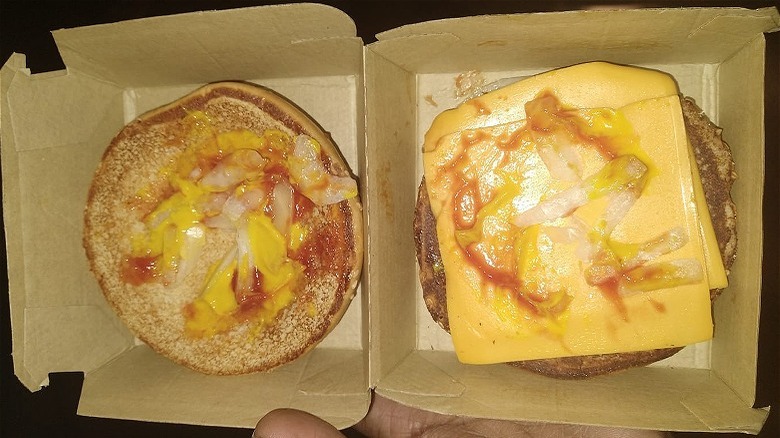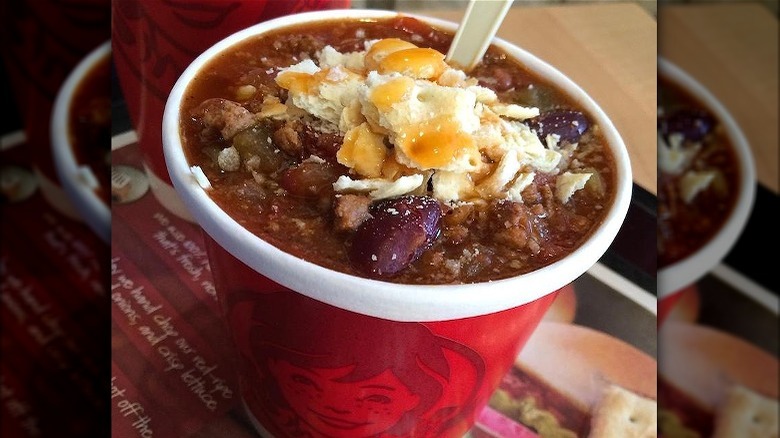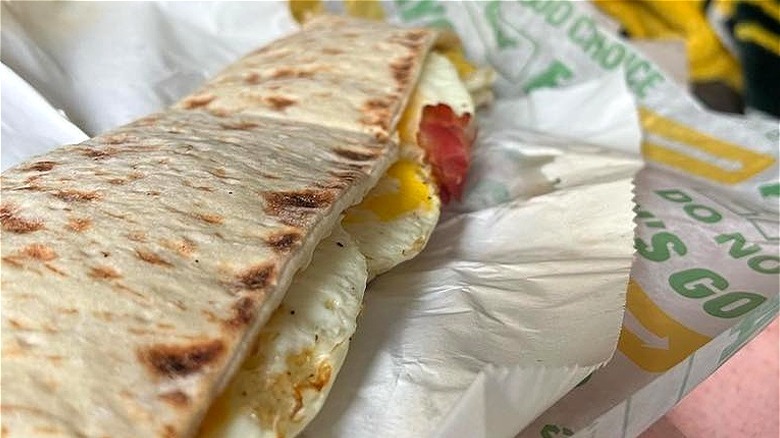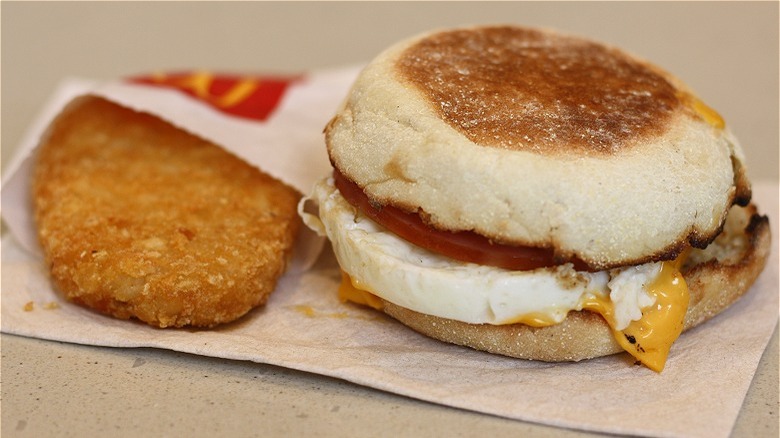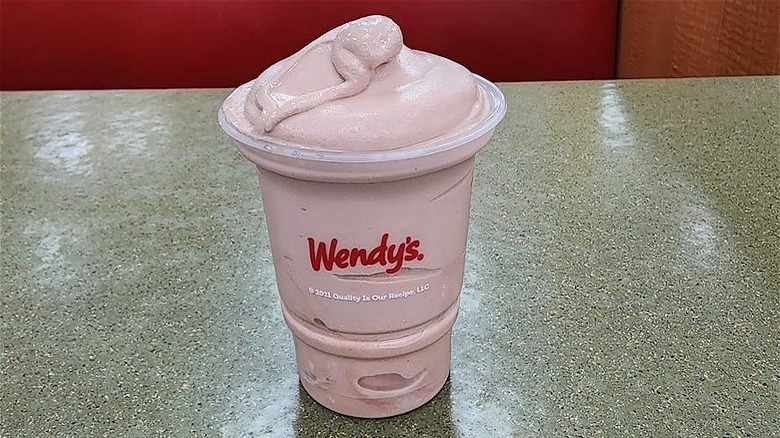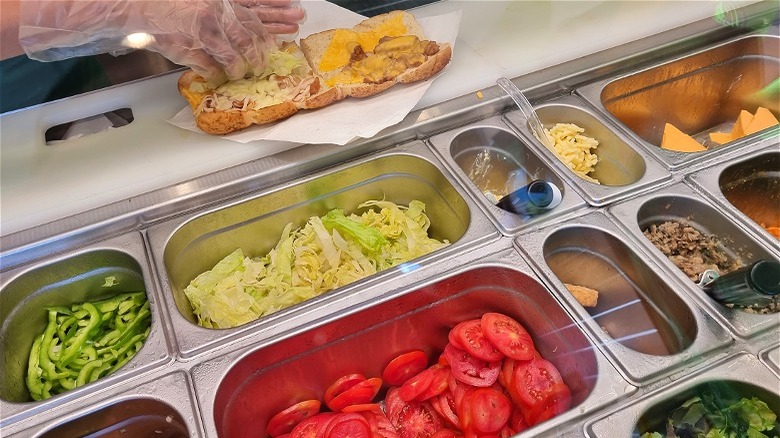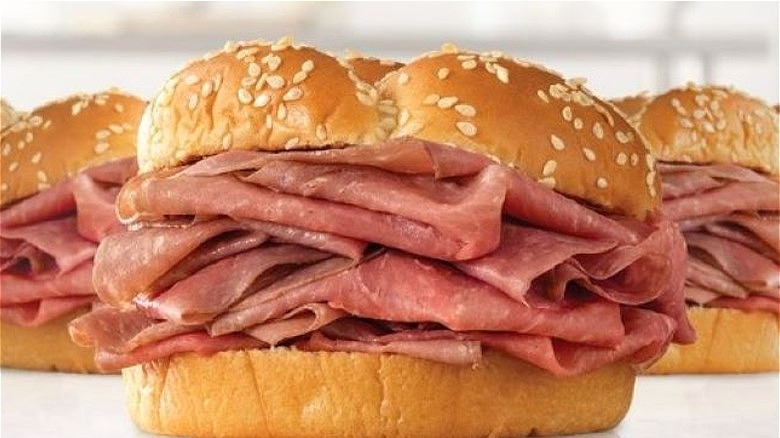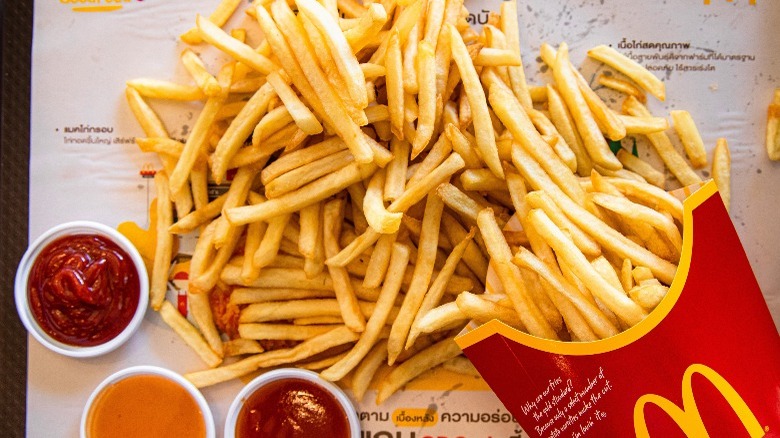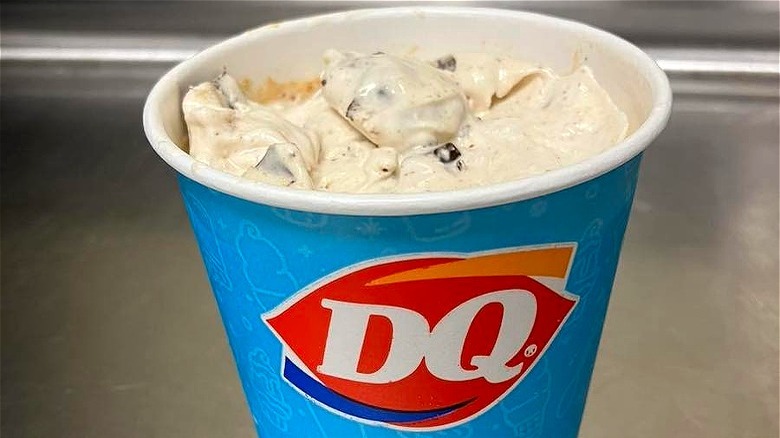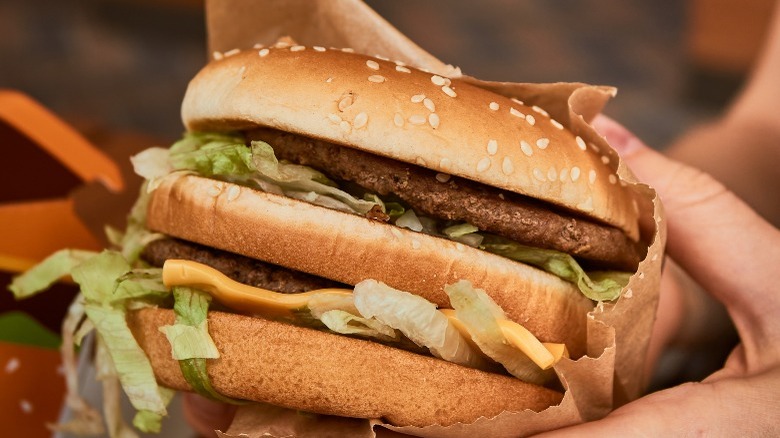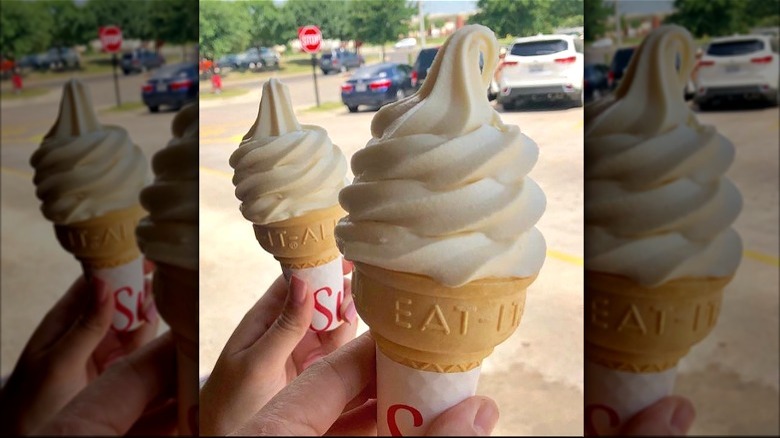Popular Fast Food Items That Aren't What You Think
Fast food menus are constantly changing as companies try to stay relevant. But no matter how long ago they were introduced to the menu, fast food menu items must be prepared and served quickly. This means that their ingredients and preparation methods are unique. Once you delve in deeper, you'll see these items are unlike homemade foods.
Some fast food menu items stick around because they're so popular. Consumers often pick favorites and stick with them. Most people are probably unaware of the nutrition information for these popular fast food products.
Certain fast food chains share detailed information about how these products are prepared, but others are much more secretive. It's important to be well-informed about the food and drinks you consume, especially the ones you consume regularly. The eye-opening info we've found may affect the way you order from these fast food chains. Here are some popular fast food items that aren't what you think.
McDonald's onions
What would a McDonald's burger be without those small pieces of onion? It sure wouldn't be as tasty. But unfortunately, those tiny onion bits might not be as fresh as you think.
These are definitely onions, but ingeniously prepared to please billions of palates around the world. The key word here is rehydration. This concept isn't unheard of. Campers often add water to dehydrated food that they bring along when preparing meals. But McDonald's takes the concept of rehydration to a different level.
McDonald's uses fresh, slivered onions on its Quarter Pounders. But its classic burgers and Big Macs use a mix of fresh and rehydrated onions, according to Newsweek. To create this mix, dehydrated onions are placed in a large tub and covered with tap water. Then, the mixture gets refrigerated for a certain amount of time. Finally, the whole thing is strained so that only onions are left behind.
Wendy's chili
Wendy's chili is sold in small or large sizes. It's made with familiar chili ingredients like tomatoes, onions, green peppers, celery, beans, and spices. But shockingly, this chili is also made with leftover hamburger pieces.
But before you recoil in horror, it kind of makes sense. Unsold, cooked burgers could just be thrown out. But Wendy's seems to think this would be wasteful. Instead, the chain boils, chops, and adds this meat to its simmering chili. This information has been shared by several Wendy's employees, such as in this Reddit post.
Chili recipes typically start by browning ground meat, then adding the other ingredients. Wendy's process changes that up since the meat used is initially cooked on a different surface, before being added to the chili pot. This means the meat could lose some of its juiciness and flavor over time. Wendy's chili prep might make one question ordering its chili again. But the truth is that, questionable preparation aside, this chain's chili still hits the spot.
Subway's eggs
Subway has been the subject of many controversies over the years. The chain has also been criticized for its eggs, and it appears these complaints are somewhat warranted.
There are three breakfast sandwiches sold by Subway, all of which are made with eggs. According to Subway's U.S. product ingredient guide, there are many additional ingredients used that go into its eggs, egg whites, and omelet patties. Subway's omelet patty contains artificial ingredients like hydrogenated soybean oil, unmodified corn starch, xanthan gum, and cellulose gum. This patty is also made with things like salt, pepper, and a liquid butter alternative. The list of ingredients for Subway's eggs and egg whites is similar.
These extra ingredients make these flatbreads unappetizing to us. Due to the many added ingredients in this company's eggs, it's probably best to have Subway for lunch or dinner. But skip the breakfast at this fast food joint.
McDonald's eggs
McDonald's eggs can't compare to homemade omelets. But no one can deny the delicious taste of a hot Egg McMuffin. The preparation methods for McDonald's eggs vary according to which menu item they're being used to make.
The iconic Egg McMuffin is made with fresh eggs, according to McDonald's. These get poured into a ring-shaped mold, so the final product fits nicely onto a round English muffin. The chain also uses fresh eggs for its scrambled eggs, as well. But there are two more McDonald's egg categories: folded eggs and pre-cooked eggs.
You'll be biting into folded eggs when you order McDonald's Bacon, Egg & Cheese Biscuit. The supplier cooks liquid eggs, folds them up to fit the biscuits, and flash-freezes them. McDonald's staff members later cook them with butter on the grill. McDonald's Sausage Burrito Eggs are made with pre-cooked liquid eggs. It's good to know which menu items contain previously frozen eggs. We'll stick with the Egg McMuffin, thank you very much.
Wendy's Frosty
Wendy's Frosty is not called a milkshake for a very good reason. But some people are still fooled into thinking it's the real thing.
For starters, the Frosty's texture is between that of a soft-serve ice cream and a milkshake. This hybrid can be eaten with a spoon. It also pairs perfectly with Wendy's fries. Unfortunately, the things used to make these drinks are not natural, according to the ingredients listed on Wendy's menu.
The first three ingredients in a chocolate Wendy's Frosty are milk, sugar, corn syrup, and cream, so it gets off to a good start. It also contains nonfat dry milk, natural vanilla flavor, and cocoa. But to get that thick consistency, the chain also adds things like carrageenan and cellulose gum. Other additions include sodium citrate and calcium sulfate. These artificial components combine to create the Frosty's unique texture. If you want an all-natural dessert made from fresh ice cream, Wendy's is not the place to get it.
Subway's lettuce
Fast food chains like Subway emphasize that their food is fresh. But sometimes, it isn't. This chain's lettuce is a prime example of an ingredient that might be served past its prime. Subway's toppings bins are full of peppers, sliced tomatoes, onions, and more. But are all of these vegetables hand-cut by employees back in the kitchens?
The answer for lettuce seems to be no, according to Business Insider. Franchisees have reported that Subway locations typically receive two or more lettuce deliveries per week. Properly refrigerated, uncut iceberg lettuce will last up to 10 days in a refrigerator. But once it's shredded, it will start to brown much sooner.
Putting lettuce into a sealed bag with paper towels can help, but it's unknown if Subway does that. Whatever they are doing to prepare their lettuce, it doesn't seem to be working. Franchise owners have complained that its lettuce often ends up becoming brown and dry quickly. Not all the lettuce at every location will be sad and wilted, but if the portion on your Subway sandwich tastes like shredded newspaper, you'll know why.
Arby's roast beef
Arby's thinly-sliced roast beef tastes great with a bit of ketchup or horseradish. But it's certainly not the same stuff you'd eat at a Sunday dinner. Claims have been made by former employees on Reddit that the beef arrives at the restaurants uncut, as compressed hunks of beef scraps. Allegedly, employees remove the blocks from bags, heat them in ovens for three hours, and slice them.
It may be real meat, but the method in which Arby's roast beef is prepared sounds a bit unappetizing. It arrives at the restaurants in bags filled with a self-basting liquid solution. This liquid contains minimal ingredients, like salt, water, and sodium phosphate — a common food additive used to cure meat products, thicken food, and act as an emulsifying agent.
While this doesn't sound like the worst thing in the world, it does end up containing a lot of sodium. The Classic size of an Arby's Roast Beef sandwich contains 970 milligrams of sodium. The FDA's recommended daily amount of sodium for adults is at most 2,300 milligrams.
McDonald's fries
It's highly unlikely that McDonald's fries will ever be removed from the chain's menu, despite ongoing confusion regarding the fries' inclusion of animal products. Back in the old days, McDonald's fries were cooked in lard made from beef fat. Nowadays, the company says that fries sold at its United Kingdom locations are no longer cooked in animal fat. This makes British fries from McDonald's suitable for vegetarians. Unfortunately, we can't say the same about fries sold in the United States.
All over the world, McDonald's fries are still a top seller. This may be because the company came up with a flavoring that mimics the taste of meat. It shows up as "natural beef flavor" on the fries' ingredient list. This flavoring is made from milk and wheat products. While it's confusing to uncover what exactly is in these fries, people who are sensitive to gluten or dairy should definitely avoid them.
Dairy Queen's Puppy Chow Blizzard
The name of this sweet treat from Dairy Queen can be pretty confusing. It may lead you to wonder if it's designed for human or animal consumption. Puppy chow is actually a sweet, crunchy snack that's also known as muddy buddies. It's made with peanut butter, chocolate, crispy cereal like Chex, and powdered sugar. Dairy Queen added it to its soft-serve menu and the Puppy Chow Blizzard was born.
While this isn't pet food, it's not ice cream, either. The FDA specifies that true ice cream must have a minimum of 10% milk fat. Dairy Queen's frozen treats have half as much. Here's the verdict: DQ's Puppy Chow Blizzard isn't real ice cream. You don't want to feed it to dogs, either. This fast food menu item contains chocolate, which is toxic for them. But still, it's a delicious treat that humans can enjoy on a hot day.
McDonald's Big Mac Sauce
Despite its specific name, people tend to think that McDonald's Big Mac Sauce is actually just Thousand Island dressing. This pink, creamy salad dressing is usually made from a combination of mayonnaise, ketchup, and sweet pickle relish. But McDonald's burger sauce recipe is a little more complicated.
McDonald's introduced its Special Sauce — along with the Big Mac — in 1968. But it's all changed over the years. Today, you can opt not to have it on your Big Mac.
But if you do, McDonald's Big Mac sauce is not as thick as this salad dressing. It's made from a long list of ingredients including soybean oil, sweet relish, water, egg yolks, high fructose corn syrup, vinegar, spices, and vegetable protein. There isn't any ketchup in this sauce. Instead, we're guessing that its pinkish hue comes from caramel color or paprika extract, both of which are also a part of the ingredient list.
Chik-fil-A's Icedream
Although its unique name may lead you to think that Chik-fil-A's Icedream is something special, this frozen dessert is actually just a soft-serve cone. This item just has one changed letter. This is probably because it can't be called ice cream.
As a soft serve, this light, airy dessert is designed to be paired with a Chik-fil-A meal. This makes sense when you think about it. Ice cream can seem like too much when it's eaten right after a heavy meal. But a light soft serve is more compatible with a chicken sandwich and waffle fries from Chik-fil-A. This chain is not the only place to think this way. You can also get a soft-serve cone from McDonald's.
If this menu item is such a disappointment to you, you can drive to an ice cream business after dinner. By the time you get there, you might be ready to eat something more substantial.

